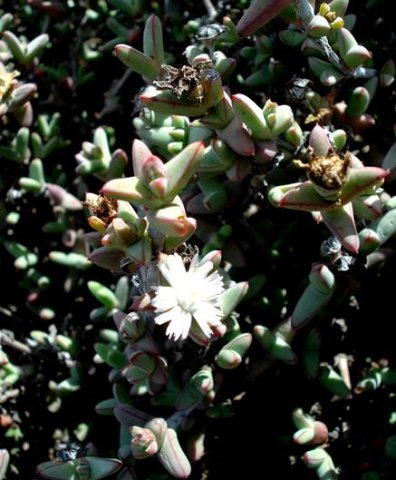Antimima

Author: Ivan Lätti
Photographer: Judd Kirkel Welwitch
Antimima is a genus of mat-forming, tufted or shrubby, leaf succulent perennials in the Aizoaceae family. The generic name is derived from the Greek word antimimos, which means imitating, referring to the resemblance of the first known species to Argyroderma.
Long shoots sometimes grow from the plant’s compact centre. Some species produce one type of leaves, others have two leaf-types. The single leaf-type may be triangular in cross-section or boat-shaped with bulging sides, otherwise the leaves may be finger-like, sometimes keeled in their upper parts. Where two leaf-types are grown, they are mostly ovoid and fused in their lower parts, enclosing the next leaf-pair during the rest season.
Leaf-tip protrusions are often present and the leaf skin cells may be flat or bulging papillae under a waxy cover.
The flowers grow solitary or in three-flowered cymes with bracts and bracteoles present below the flowers on the pedicels. The sometimes strongly fragrant flowers open in the morning and close in the evening.
The petals are arranged in five, sometimes six groups, caused by the positioning of the sepals that part them. Petal colour is mostly pink or purple, rarely white.
The stamens are together in an erect cone, surrounded by staminodes. There is a shallowly notched nectary in the flower base. The ovary has placentas at the base or inside the outer walls, where the ovules are attached. There are five or six tapering stigmas in a flower.
Flowering happens mostly in winter but may continue throughout the year.
The stalked fruit capsule comprises five or six locules and retains bracteoles on the pedicel. The covering membranes are generally wavy, rarely straight; mostly raised in the centre and winged. There are usually large closing bodies present, as well as broad expanding keels. The valves sometimes have wings.
There are about 106 Antimima species, many of which have been transferred from Ruschia late in the twentieth century. Most species grow in the winter rainfall western part of southern Africa from Namibia to the Northern and Western Cape, also into the Eastern Cape. Few species occur in the Great Karoo and the Free State.
The plant in picture is Antimima paripetala (Leistner, (Ed.), 2000; Smith, et al, 1998; Wikipedia).

